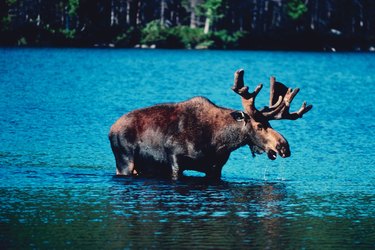
Moose is one of the most richly flavored game meats, and if you're fortunate enough to bag one -- or have a hunter in the family who has -- their sheer size guarantees you'll have lots of opportunity to learn how to cook it. Like other wild game moose's flavor and tenderness will vary widely depending on its diet, habitat, how clean a kill it was and how quickly the hunter cleaned and chilled the carcass. Most of the meat will be relatively tough, though the loin and rib sections will yield excellent roasts.
About Moose Meat
Video of the Day
Moose are at their well-fed peak in the fall, after building their winter stores of fat, but will always be leaner than domesticated meats or farmed venison. Like grass-fed beef, you'll need to cook moose at a lower temperature than well-marbled beef, and usually for a shorter time because the fat in beef acts as an insulator. If your moose is especially strong in flavor, you may want to marinate it for a few days before roasting it, in the European fashion. Traditional marinades usually include red wine, onions, bay leaves, garlic, black peppercorns and other flavoring ingredients such as juniper berries or red currants.
Video of the Day
Choosing Your Roasts
Most of the meat on an adult moose is quite tough, and not well suited for roasting. It can be used as flavorful stew meat or ground for use in spaghetti sauce and burgers, but doesn't work well for roasting or grilling. The rib and loin portions of the moose are the best for grilling or a conventional oven roast. Even on an old buck, these cuts are tender enough to be enjoyable. The other section that yields a passable roast is the shoulder, which has some marbling. The shoulder requires slow cooking, either in the oven or as a pot roast.
Rib or Loin Roast
Prepare a rib or loin roast the same way you would a beef roast, by seasoning it lightly with salt and pepper. The loin is very lean, and it's best to cover it with thin strips of bacon or pork fat to protect it from drying out in the oven. The rib has enough fat to not require special treatment. Roast the moose at 300 F or 325 F until it reaches an internal temperature of 140 F or higher, when tested with a thermometer. If trichinosis is a risk in your area, cook the roast well done, to 160 F.
Shoulder Roast
A shoulder roast requires long, slow cooking and won't be tender enough to serve when it's medium-rare or rare. Brown the outside surfaces in a hot skillet before roasting, since the low-temperature roasting method won't leave the surface browned and savory. Cover the roast with a few strips of bacon and cook it at 250 F in a covered roasting pan for four to six hours, until fork-tender. With either a shoulder roast or the rib or loin roasts, let the meat rest for 10 to 15 minutes before carving. This makes for a juicier roast.